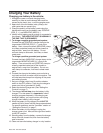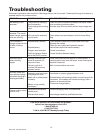
6
Sears 440 - Sch 516 9/16/95
A TEMPORARY adapter may be used to connect the
charger to a two-pole outlet if a properly grounded
outlet is not available. Use the adapter ONLY until a
properly grounded outlet can be installed by a qualified
electrician.
DANGER: Before using an adapter as illustrated, be
certain that the center screw of the outlet plate is
grounded. The green colored grounding clip of the
adapter must be attached by a screw to a properly
grounded outlet. If unsure whether outlet is properly
grounded, contact a professional electrician. If neces-
sary, replace the original outlet cover screw with a
longer one that will secure the grounding clip to the
outlet cover and make a ground connection to the
grounded outlet.
Using an extension cord
The use of an extension cord is not recommended. If
you must use an extension cord, please make sure
that you follow these guidelines:
•Make sure the pins on the plug of the extension cord
are the same number, size, and shape as those of the
plug on the charger.
• Use only 3-conductor (grounded) extension cord
when necessary.
•Check that the extension cord is properly wired and
in good electrical condition.
•Use the recommemnded minumum AWG (American
Wire Gauge) to be sure that wire size is large enough
for the rating of the charger.
MINIMUM RECOMMENDED EXTENSION CORD
Length of Cord, in Feet 25 50 100 150
AWG* Size of Cord 18 14 12 10
*AWG=American Wire Gauge
Preparing your battery to be charged
It is important that you read and follow these guidelines
while you are preparing to charge your battery.
•Make sure that you have a 12 volt lead-acid battery.
Clean the battery terminals. Be careful to keep
corrosion from getting in or around your eyes.
•If you have a battery with removable cell caps, if
required, add distilled water to each cell until the
battery acid reaches the level indicated by the
manufacturer. This will help purge excessive gases
from the cells. Be careful not to overfill. If you have a
sealed battery without cell caps, no action is neces-
sary. Continue to the next step listed below.
•Take time to read all battery manufacturer’s specific
precautions, such as removing or not removing
cell caps while charging, and recommended rates
of charge.
• Wear safety glasses. See additional "Personal
Safety Precautions" on page 2.
• Be sure that the area around the battery is well
ventilated while it is being charged. If ventilation is
poor, gas can be manually blown away by using a
piece of cardboard or other non-metallic material as
a fan.
• If it is necessary to remove the battery from the
vehicle to charge it, always remove the grounded
terminal from the battery first. A spark may be
caused if all accessories in the vehicle are not
completely turned off.
NOTE: A marine battery installed in a boat must be
removed and charged on shore.
















